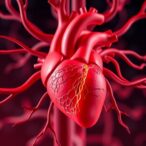
In a groundbreaking convergence of artificial intelligence and biomedical research, scientists at the University of Cambridge have harnessed the capabilities of GPT-4, a leading large language model (LLM), to revolutionize drug discovery for breast cancer treatment. Moving beyond traditional approaches that focus primarily on developing entirely new compounds, this interdisciplinary team utilized AI-driven insights to unearth unconventional and affordable drug combinations that could potentially transform cancer care. This research marks a significant step towards integrating AI as an active participant in the scientific process, rather than a mere computational tool.
The study employed GPT-4’s remarkable ability to process vast volumes of scientific literature, extracting subtle patterns and relationships invisible to human researchers alone. By instructing the model to prioritize combinations of already-approved, low-cost, and non-toxic drugs—while specifically excluding standard cancer therapies—the researchers aimed to catalog new therapeutic avenues that might have remained obscured within the existing biomedical corpus. This paradigm of leveraging AI to decode hidden complexities presents a promising strategy to accelerate the notoriously lengthy and costly journey of drug development.
Initial experiments focused on a well-established breast cancer cell line frequently used in laboratory research. The team prompted GPT-4 to generate drug combinations with the highest likelihood of selectively killing cancerous cells without damaging healthy tissue, emphasizing safety and regulatory approval to facilitate rapid clinical translation. From the AI’s suggestions, twelve distinct drug combinations emerged as candidates for laboratory validation, highlighting the model’s capacity to navigate a vast hypothesis space efficiently.
.adsslot_SZwuTX6JMB{width:728px !important;height:90px !important;}
@media(max-width:1199px){ .adsslot_SZwuTX6JMB{width:468px !important;height:60px !important;}
}
@media(max-width:767px){ .adsslot_SZwuTX6JMB{width:320px !important;height:50px !important;}
}
ADVERTISEMENT
Subsequent in vitro testing revealed a remarkable outcome: three of these twelve AI-suggested drug pairs demonstrated superior efficacy compared to existing breast cancer treatments. Rather than halting at this juncture, the research team integrated these experimental results back into the GPT-4 framework to retrain and refine the model’s hypothesis-generating capabilities. This iterative closed-loop system—where AI recommendations fuel experiments, and experimental insights in turn guide AI learning—embodies a novel methodology for scientific inquiry, enabling dynamic co-evolution of human and machine intelligence.
Following this adaptive feedback, GPT-4 put forward an additional four drug combinations. Of these, three again exhibited promising laboratory results, reaffirming the model’s capacity to propose chemically and biologically plausible therapeutic strategies. This cyclical process of hypothesis generation, empirical testing, and algorithmic refinement represents a significant departure from traditional drug discovery pipelines, which often operate in a linear, time-intensive fashion with limited iterative feedback from experimental data.
Central to the success of this venture is the novel conceptualization of AI as a “supervised researcher” rather than an autonomous entity. While large language models such as GPT-4 are well-known for occasionally fabricating information—referred to as “hallucinations”—these inaccuracies have paradoxically served as a creative asset in this context. The human-scientist collaborators meticulously evaluated and probed these AI-originated hypotheses, considering mechanistic rationales and biological plausibility, thereby validating both anticipated and unexpected drug synergies.
Among the standout combinations identified through this AI-guided approach are simvastatin, a cholesterol-lowering agent, and disulfiram, a drug traditionally used to treat alcohol dependence. Neither of these compounds had been conventionally associated with oncology, yet their combined application manifested significant inhibitory effects on breast cancer cells in laboratory assays. Such findings open exciting possibilities for drug repurposing, where existing medications with established safety profiles can be redirected against cancer, potentially reducing time and costs relative to developing new drugs from scratch.
The broader implications of this research extend beyond breast cancer. The methodology exemplifies how AI can be embedded into the continuous loop of hypothesis generation and validation in real time, facilitating adaptive, data-driven scientific discovery. By seamlessly integrating biological insights with AI’s pattern recognition capabilities, researchers can navigate the immense chemical universe more effectively, focusing experimental resources on high-probability candidates that might otherwise be overlooked.
Professor Ross King, who led the study from Cambridge’s Department of Chemical Engineering and Biotechnology, emphasized the transformative potential of this collaboration. According to him, supervised large language models represent an imaginative scientific layer that augments human inquiry, tackling complexity at a scale unmanageable by human cognition alone. This approach embodies a vision where AI acts not as a replacement, but as an indispensable research partner, amplifying creativity and efficiency in drug discovery workflows.
Dr. Hector Zenil from King’s College London further elucidated the partnership dynamics between AI and human researchers. He described the AI as a tireless collaborator capable of rapidly traversing an immense hypothesis space, offering novel ideas at a pace unattainable by humans working in isolation. The iterative interplay between expert-guided prompts, mechanistic evaluations, and experimental feedback forms a harmonious feedback loop, driving accelerated discovery.
The research also underscores a critical paradigm shift in how AI outputs are interpreted. Where hallucinations have traditionally been viewed as problematic errors, in this context, they have become conduits for innovation—proposing unconventional drug combinations that, upon rigorous assessment, reveal valuable therapeutic insights. This inversion of AI “flaws” into productive features exemplifies the maturity of supervised AI applications in high-stakes scientific domains.
The promising drug combinations identified undergo rigorous preclinical and clinical evaluation before any translation into human treatments. Nonetheless, the validation of this closed-loop AI-human collaboration marks an unprecedented milestone. It demonstrates a scalable framework through which AI can assist in hypothesis generation, adapt through experimental results, and expedite translational research, particularly in complex fields like oncology where the multidimensional interplay of pathways is difficult to unravel.
Funded partly by the Alice Wallenberg Foundation and the UK’s Engineering and Physical Sciences Research Council (EPSRC), this research heralds a new era of AI-augmented scientific discovery. It presents a compelling vision for the future, wherein large language models and human scientists co-create knowledge, test hypotheses, and push the boundaries of biomedical innovation together.
Subject of Research: Not applicable
Article Title: Scientific Hypothesis Generation by Large Language Models: Laboratory Validation in Breast Cancer Treatment
News Publication Date: 4-Jun-2025
Keywords: Artificial intelligence, Drug discovery, Drug development
Tags: accelerating drug development with AIaffordable cancer therapiesAI in drug discoveryAI-driven insights in oncologybreast cancer treatment innovationsCambridge University cancer researchdrug repurposing strategiesGPT-4 in biomedical researchinterdisciplinary approaches to drug developmentleveraging AI in scientific researchnon-cancer drug combinations for cancer treatmentunconventional cancer therapies


